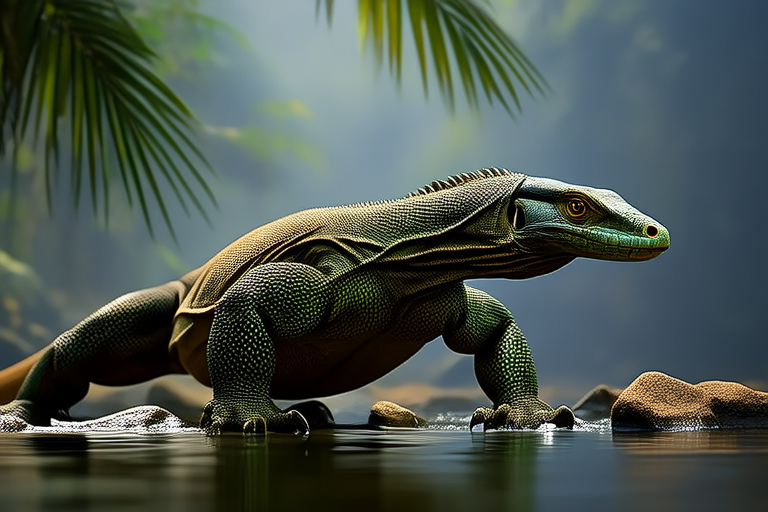Unleashing the Mystique: All You Need to Know About Water Monitors
Water monitors (Varanus salvator) are among the most fascinating reptiles in the world. Known for their remarkable agility and adaptability, these creatures possess unique characteristics that set them apart from other lizards. They are large, semi-aquatic monitor lizards native to Southeast Asia, where they thrive in diverse environments. This article delves into the intriguing world of water monitors, covering their habitat, diet, behavior, physical attributes, conservation status, and the challenges faced by those who consider keeping them as pets.
Introduction: The Unique Characteristics of Water Monitors
Water monitors are renowned for their exceptional swimming abilities, which allow them to dive deep and stay submerged for extended periods. Their powerful limbs enable them to climb trees with ease, while their sharp claws make them adept at digging. These traits combine to create a versatile predator capable of thriving in both aquatic and terrestrial habitats. Additionally, water monitors have excellent eyesight and sense of smell, which help them locate prey even in murky waters.
Habitat, Diet, and Behavior
Habitat
Water monitors inhabit a wide range of environments across Southeast Asia, including mangrove swamps, rivers, lakes, and coastal areas. They prefer areas with abundant vegetation, as it provides cover and shelter from predators. These adaptable reptiles can also be found in rice paddies and agricultural fields, where they may feed on small animals or insects.
Diet
As opportunistic feeders, water monitors have a varied diet that includes fish, frogs, birds, rodents, and even carrion. Juvenile monitors primarily consume insects and small invertebrates, gradually transitioning to larger prey as they grow. In some cases, water monitors have been observed eating poisonous snakes without apparent ill effects, showcasing their resilience and adaptability.
Behavior
Water monitors are generally solitary creatures, except during breeding season. They are territorial and may engage in aggressive displays or fights when threatened or competing for resources. Despite their formidable appearance, water monitors play a crucial role in maintaining ecological balance within their ecosystems by controlling populations of smaller animals.
Physical Attributes
Size and Appearance
Water monitors are among the largest lizards in the world, with males typically reaching lengths of up to 7 feet (2.1 meters). Females tend to be slightly smaller, but both sexes exhibit impressive growth rates. Their bodies are elongated and muscular, with strong legs and a long tail used for swimming and balance. Water monitors have distinctive patterns of dark bands on their backs, which provide camouflage against predators.
Conservation Status and Threats
Despite their widespread distribution, water monitors face several threats due to habitat loss, poaching, and illegal trade. Many regions experience deforestation and land conversion for agriculture, reducing available habitats for these reptiles. Additionally, water monitors are often hunted for their meat, skin, and eggs, leading to declines in local populations. Conservation efforts focus on protecting critical habitats and raising awareness about the importance of preserving these magnificent creatures.
Tips for Pet Owners
Care Requirements
For those considering owning a water monitor as a pet, understanding their specific needs is essential. Water monitors require spacious enclosures that mimic their natural environment, complete with branches for climbing, rocks for basking, and a large water area for swimming. Maintaining appropriate temperature gradients within the enclosure ensures optimal health, with basking spots around 95°F (35°C) and cooler areas around 80°F (27°C).
Housing
Adequate housing is paramount for the well-being of your water monitor. Enclosures should be escape-proof, with secure lids or tops to prevent accidental escapes. Providing ample space allows the lizard to move freely and exercise, promoting good health and longevity. Regular cleaning and maintenance of the enclosure ensure a hygienic living environment.
Legal Considerations
Before acquiring a water monitor, research local regulations regarding exotic pet ownership. Some countries and states impose restrictions on keeping certain species, requiring permits or licenses. It’s important to understand these requirements and comply with all relevant laws to avoid legal issues.
The Importance of Respecting Water Monitors in Their Natural Habitats
While water monitors can make fascinating pets for experienced keepers, it’s crucial to remember that they belong in their natural habitats. Preserving these environments helps maintain biodiversity and supports healthy ecosystems. By supporting conservation initiatives and responsible wildlife tourism, we can contribute to the protection of water monitors and other vulnerable species.
In conclusion, water monitors are captivating reptiles with unique characteristics that make them stand out among other lizards. Understanding their habitat, diet, behavior, physical attributes, and conservation status provides valuable insights into these remarkable creatures. For those interested in owning a water monitor as a pet, proper care, housing, and legal compliance are vital. Ultimately, respecting water monitors in their natural habitats ensures their survival and contributes to the preservation of our planet’s rich biodiversity.
